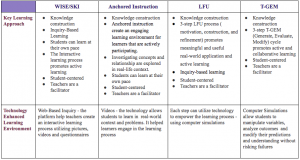
The four frameworks we explored in STEM education could be applied to all curriculum areas to guide educators’ effective use of technology-enhanced environments in classrooms. Each framework places the learner in the center of learning and promotes constructivism by construction of knowledge, promotion of critical thinking, analysis of information, communication and collaboration. These skills are required for students to succeed in the 21st century.
The similarities of the four frameworks are 1. The role of the teacher as a facilitator, course designer, and motivator. TELEs require teachers to make a pedagogical shift in their STEM teaching from transmission of knowledge to collaborative construction of knowledge with the learner. 2. The frameworks promote constructive learning environments. 4 TELEs promote active learning that requires critical thinking, data analysis, investigate concepts and relationships, sharing and collaboration. 3. 4 TELEs use technology to aid the learning processes.
Utilizing technology in STEM education can have a great impact on student learning. However, we must have a clear purpose when utilizing technology in each course. The use of technology is to help students visualize complicated/abstract concepts, use real world data, practice and engage in real world applications through simulations, and even leverage virtual or augmented reality to enhance understanding. Technology provides students with the learning environment that allows them to control their learning process.
References:
Cognition and Technology Group at Vanderbilt. (1993). Anchored instruction and situated cognition revisited. Educational Technology, 33(3), 52-70.
Edelson, D.C. (2001). Learning-for-use: A framework for the design of technology-supported inquiry activities. Journal of Research in Science Teaching,38(3), 355-385.
Khan, Samia (2011). New pedagogies on teaching science with computer simulations. Journal of Science Education and Technology 20, 3 pp. 215-232.
Williams, M. Linn, M.C. Ammon, P. & Gearhart, M. (2004). Learning to teach inquiry science in a technology-based environment: A case study. Journal of Science Education and Technology, 13(2), 189-206.
I’m having some trouble reading your comparison table, as it appears a bit blurry, but the overall organization of your information looks as though it presents a thorough summary. I agree with your synthesis of the TELEs and the importance of constructivist, collaborative learning environments. I think that your emphasis on having a clear purpose for the integration of technology is extremely important for us to bear in mind consistently. One question that I often have, especially when integrating “new” technology into the classroom, is how much time and/or emphasis do we place on learning how to use the technology versus learning through the technology?
On a technical note, I can now read your comparison table. It seems that it was an issue on my end.
Hi Allen
I firmly believe that we need to be cautious on implementing technology in classes because technology that is not carefully evaluated can be a huge distraction. I also want to emphasize that the process of implementing technology should be quick and easy so teachers can spend more time on class curriculum than learning technology. Hooper & Rieber (1995) states that the most important aspect of integrating educational technology is to create learning environments in which students actively construct knowledge in cognitive partnerships with technology.
Reference:
Hooper, S. & Rieber, L.P. (1995). Teaching with technology. In A.C. Ornstein (Ed.), Teaching: Theory into practice (pp. 154-170). Needham Heights, MA: Allyn and Bacon.
Great visual! I like how you mention that technology can have a great impact on student learning, however “we must have a clear purpose when utilizing technology in each course”. I was introduced to the Bates SECTIONS model and this became extremely helpful when deciding which technology I wanted to use with my students when applying for a technology grant.
Hi Danielle
I agree with you that the SECTIONS are a great guide on integrating technologies into teaching/learning. I use the model when choosing technologies in our company as well. The model also works great within a corporate learning environment.
Hi YooYoung
I like the fact that you made a graphic comparing the four TELEs
I wonder how many teachers are willing to make “a pedagogical shift in their STEM teaching”? My belief is 1/3 of the teachers would –even if they have to do extra work — like the teachers in MET program. 1/3 would if the information and tools were in front of them. And 1/3 would not. Do you think my 1/3 rule is valid?
A good next step might be to add an example to each of the TELEs that you have used or would like to use in your own classroom.
Christopher